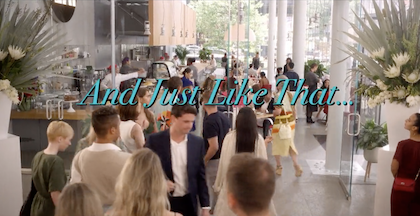A critique of the forced diversity and unnecessary existence of the new “Sex and the City” reboot
By ANGIE CUMMINGS — arts@theaggie.org
Watching all 10 episodes of “And Just Like That…” Season One was perhaps the most intense form of investigative journalism — it really was that bad. As happened for most people, headlines about the show piled so high right from the beginning that it was easy to avoid watching it, as almost everything that occurred on the show was torn to shreds by media outlets and everyone on the internet. Be warned, the show itself is far worse than just the numerous forced and inconsistent storylines everyone has heard about; it is entirely unenjoyable.
The easiest way to understand why “And Just Like That…” was so bad is to remember why “Sex and the City” (SATC) was good in the first place. Premiering over 20 years ago, SATC was regarded as a part of the “golden age of TV” and a huge step in the right direction for the representation of both close female friendship and the portrayal of sex on TV. Now, the show is not so much regarded as a revolutionary feminist representation of sexuality and friendship, but as an enjoyable (and equally problematic) show about four rich white women having fun in their upper-class bubble of New York City.
Rewatching the original show, you are confronted with tokenistic characters of almost every marginalized group, offensive remarks by all of the leading ladies and a general lack of awareness of the real world. The issues with SATC are as clear as day, and are exactly what showrunners are slowly learning from.
The bottom line is that a reboot trying to fix all the issues of the original show was never going to work. Not to mention, a reboot without Samantha Jones (Kim Cattrall), arguably the backbone of the show’s entertainment value, already set it up for failure. In the process of “woke-washing” the show, the creators lost sight of really the only redeemable aspects of the original — an accurate presentation of friendship and a light-hearted, fantastical display of the world around the characters.
From the first five minutes it was clear the writers searched for trending topics from the last three years and jammed them into the script. Everything felt wrong, from the cringeworthy fake post-COVID jokes to Carrie’s logic-defying podcast. In all honesty, there were scenes in which the show felt like a training video for old people on how to not be offensive in public, made complete by Charlotte’s education in pronouns, Carrie’s introduction to cultural appropriation vs. appreciation and Miranda’s “white-savior” education.
Perhaps the only actually open-minded aspect of “And Just Like That…” was having a non-binary character, Che Diaz — but they’re entirely unlikable, showing that anyone can be annoying, regardless of their sexuality or gender expression. Che, played by the incredibly talented Sara Ramirez, is an unfunny stand-up comedian that Miranda Hobbes falls head-over-heels for after having about two-and-a-half conversations with them.
While sapphic representation is something that should always be fought for in Hollywood, this particular relationship maybe isn’t worth the effort. Not only did the show completely change Miranda’s character — with the only explanation being “people change!” — but it also made her a horrible friend (and wife, sorry Steve). One consistency in this show was Charlotte’s borderline conservative outlook on the world, which is shaken to its core by her first close Black friend (there are multiple scenes where this causes her some serious strife) and her child coming out as gender non-conforming.
Perhaps a show about extremely wealthy, privileged and late-middle-aged white women is not the one to deal with these serious, deeply rooted socio-political issues surrounding race and identity — of which these women are essentially just spectators. Oftentimes, it felt as if the showrunners were playing some twisted game of diversity bingo. Despite creating pockets of space for underrepresented groups within this show, they failed to correct (or even show how they have learned from) the wrongs of the past.
I’m no expert, but I do feel that the solution to the issue of representation and diversity of experience in TV is to create a completely different show starring those who have been excluded from narratives all these years, not to simply stick them alongside the old white women who have been in the spotlight all along.
Written by: Angie Cummings — arts@theaggie.org




